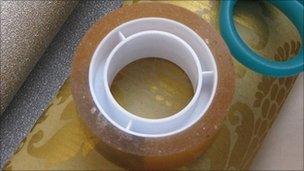How sticky tape trick led to Nobel Prize
- Published

Sticky tape was the unlikely route to a Nobel prize for these researchers
It sounds like an unusual way to win a Nobel Prize.
But ordinary sticky tape was crucial to the breakthrough that yielded graphene, a material with amazing properties and - potentially - numerous practical applications.
Graphene is a flat layer of carbon atoms tightly packed into a two-dimensional honeycomb arrangement.
It is both the thinnest and the strongest material known to science, and it conducts electricity better than copper.
This year's winners of the physics prize, Andre Geim and Konstantin Novoselov, from Manchester University, UK, extracted graphene from the common material known as graphite - widely used as the "lead" in pencils.
Placing the adhesive tape on the graphite, they managed to rip off thin flakes of carbon. In the beginning they got flakes consisting of many layers of graphene.
But as they repeated the process many times, the flakes got thinner.
Thin flakes
In an interview with the Sciencewatch website, external two years ago, Professor Geim described the method thus: "You put [sticky tape] on graphite or mica and peel the top layer. There are flakes of graphite that come off on your tape.
"Then you fold the tape in half and stick it to the flakes on top and split them again. And you repeat this procedure 10 or 20 times. Each time, the flakes split into thinner and thinner flakes.
"At the end you're left with very thin flakes attached to your tape. You dissolve the tape and everything goes into solution."
At the time, many scientists believed it was impossible for such thin crystalline materials to be stable.
Contrary to expectations, the the thin flakes did not lump together or scroll in solution.
What the researchers had produced was still graphite, a few layers thick. But it was a significant advance that allowed the researchers to start making transistors from the thin flakes of carbon.
The electrical properties of graphene mean that it is the prime candidate to replace silicon in transistors - the switches that change the flow of current and form the heart of computers and other electronics.
Feeling normal
In order to identify the minuscule fragments of graphene, the researchers transferred the thin layers of graphite they had created using the sticky tape to a plate made of oxidised silicon.
When the plate was placed under a standard microscope, a rainbow of colours was revealed, similar to what is seen when oil is spilled onto water. This allowed the researchers to determine the number of graphene layers in the flakes.
There are now more sophisticated ways to produce graphene and the list of potential applications is endless. Scientists say it could find uses in transparent touch screens and solar cells.
A tiny amount mixed into plastics could also turn them into electrical conductors.
Speaking to BBC News about the recognition of his work's significance by the Nobel committee, Professor Geim was nonchalant: "It feels normal," he said.
Smiling, he added: "It made a lot of effects on today's routine, I planned to go to work and work hard and write a couple of papers and produce something good. But instead I have been doing interviews. So it has been detrimental to today's science."
- Published5 October 2010
- Published4 October 2010